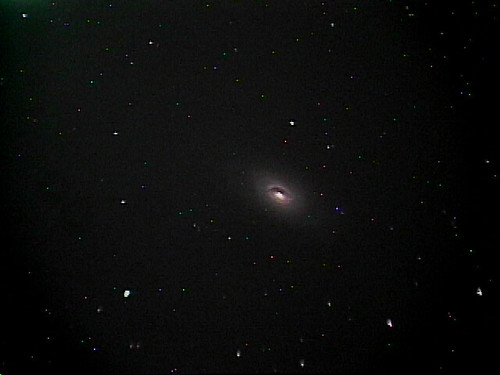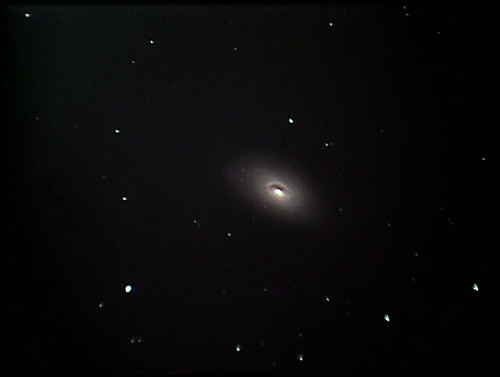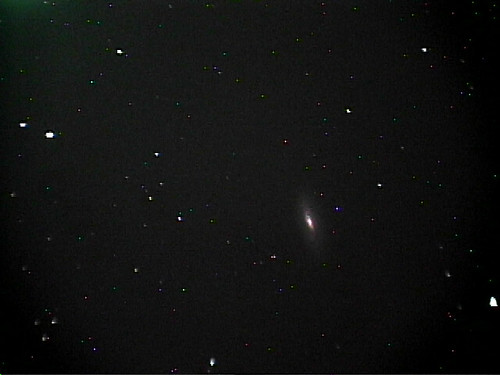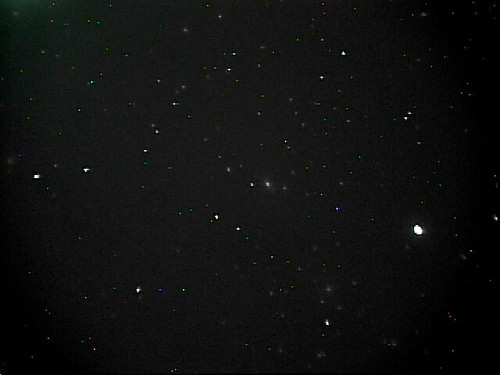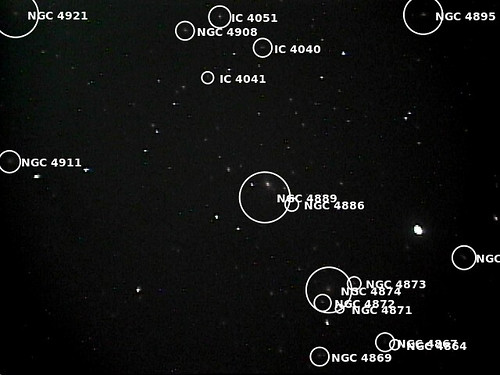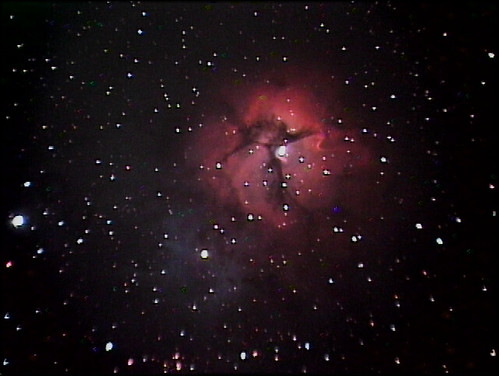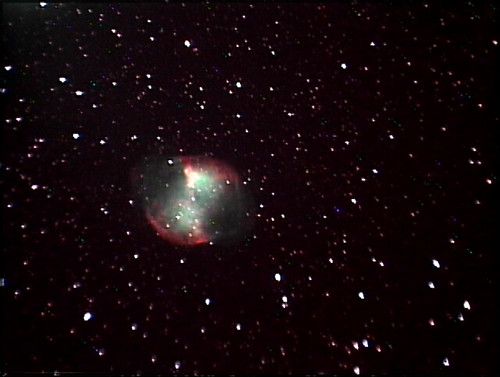As spring has turned into summer we are up against our last few chances to look at the really faint fuzzies in the spring sky. I refer of course to the mega-clusters of galaxies in Virgo and Coma Berenices. This week in Pittsburgh has been miraculously clear from summer haze, and my telescope mount has been miraculously clear from strange mechanical hiccups, which means I have spent a last few quality hours with the galaxies this week.
My first stop for the night was M64. I had found that the only image I had of M64 was a bit of a blurry mess because the focus of my telescope had gone off as a I captured it. So I took another shot at it, and it came out better:
This is about a 1 minute exposure. I also used the opportunity afforded by a well behaved mount to take 5 separate frames at 1 minute, and also a “dark” frame with the telescope covered up. I then used a cool program called Nebulosity to combine all these images and use the dark frame to clean up warm pixel noise and generally smooth things out. The result is this:
Noticeably nicer, without a whole lot more work.
After M64, I hopped over to the nearby NGC 5005 to add a new object to my “observed” list. The main reason people buy telescopes is to collect objects into an “observed” list. Anyway, this proved to be a nicer object than some of the smaller “M” galaxies in the area, with a pretty compact spiral:
From there, I then jumped into the Coma Berenices cluster and got the surprise of the night. I centerd my frame on the galaxy known as (I thought) NGC 4889. But, as you can see from the picture, the object is really small. I wasn’t really sure what I was looking at. To make things more confusing, Skytools did not think that there was any object named NGC 4889. It only knew about NGC 4884. Well, it turns out that one of many bugs in the NGC catalog is that these two objects are the same. There is only 4884. This mystery solved I stared at the field of view for a while, and noted a ton of little “stars” that looked suspiciously fuzzy. What could those be?
Since we live in the future there is an oracle in the sky that can tell us what these things are now, and all you have to do is send it a simple picture. I refer, of course, to the Astronmetry blind plate solver. I have mentioned this engine before, but at the time I did not give it enough extended credit. This system is as close to magic as we can get in the modern world. Best of all, it combines all three major dork passions into one glorious nexus of geekdom: it’s a computer that processes photographs and tells you what astronomical objects you telescope is pointing at.
Here is the picture I sent it:
The astrometry bot extracts everything out of the frame that looks like a star, and then compares the star patterns with a huge index that has been built from one of the more comprehensive catalogs of all stars down to some ridiculously faint magnitude. If it can find a strong enough match in this index, then with no information other than a noisy image, the system can tell you:
1. The exact celestial coordinates of the center of the picture.
2. The size of the field of view.
3. The name of every interesting object in the field.
4. Which way points north.
And so on. This used to take hours of painstaking work comparing your picture against a paper atlas. Now you send a picture to a web site and wait about 45 seconds, and you get back something like this:
The only thing more magical would be if it ran natively on an iPad (ha ha).
What the astrometry bot told me was that I had wandered in to a huge cluster of galactic bodies. The frame contains seventeen island universes each made up of hundreds of millions of stars. Truly a fantastic sight.
I rounded out the night with a reminder of what is to come over the next couple of months. I sent the telescope over to one of my favorite objects, the Trifid Nebula (M20). Images of this object through a six inch scope were what convinced me to take the plunge at the Mallincam in the first place, and the camera did not let me down. Here is a set of five frames, 45 seconds of exposure in each:
It should not be possible that this looks this good. Especially since the area of the sky this sits in is in the worst of the light pollution in my yard (to the south and west).
I’m looking forward to shifting from galaxy hunting to looking at the great nebulas of the summer. As another teaser, here is the Dumbbell (M27).
I think I’ll go to bed early tonight.

